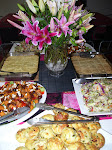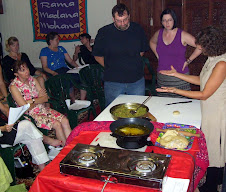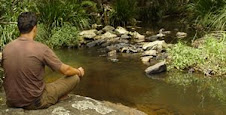Wednesday, November 11, 2009
Vegetarian Cooking Classes 2010
Feb: 27th Authentic Vietnamese
April: 17th Tastes of the Himalayas
June: 26th Moroccan Delights
August: 28th Exotic Indian
Oct: 23rd Thai Temptations
Classes are held from 2-6pm, cost is $35 and includes recipe sheets and full buffet meal. For enquiries please call 3895 8944 or email us at brisbane@asm.org.au
Namaste
Gayatri
Tuesday, July 14, 2009
Malpoora Soft Cakes in Yoghurt
1 cup icing sugar
1 ¼ cups cold water
ghee for deep frying
5 cups natural yoghurt, chilled
¾ cup caster sugar
1 ½ cups strawberries, washed and quartered
· Sift the flour and icing sugar into a bowl. Add the water gradually, stirring with a wire whisk until the mixture reaches a consistency somewhere between batter and dough. Spoon in 1 tablespoon of yoghurt and whisk again. Allow to sit for 15 minutes.
· Heat the ghee with a depth of 7cm to moderately low heat 160C.
· Spoon a tablespoon of batter from the bowl and scrape it into the ghee with a second spoon. Quickly do this for about 6 cakes at a time in the ghee. Allow the cakes to inflate and then roll them over with a slotted spoon to fry for about 3 – 4 minutes until they are golden brown all over. Remove and drain. Fry more batches until the batter is used up.
· Combine the yoghurt and cater sugar in a bowl. Crush a few strawberries into the yoghurt with your fingers and then add the other strawberries and mix through.
· Carefully fold the fried cakes into the fruit yoghurt and refrigerate about 30 minutes before serving.
Gayatri
Instructor
Australian School of Meditation and Yoga
Sunday, June 7, 2009
Pushpanna (Flower Rice)

225g fresh ricotta cheese
2/4 cup cashews or blanched almonds
11/2 cups grated coconut
6 tbs ghee
1 tsp fennel seeds
1 tsp cumin seeds
2 bay leaves
6 cardamom pods, bruised
1 tsp turmeric
2 tsp ground coriander
1 tsp turmeric
1 tsp grated nutmeg
1 tsp ground cinnamon
½ tsp cayenne pepper
½ tsp asafetida
½ tsp ground black pepper
¼ tsp ground cloves
2 cups basmati rice
¾ cup raisins
3 ½ cups water
½ cup sugar
1 tbs salt
* Cube the ricotta cheese and fry until golden brown and drain well
* Toast the grated coconut in 2 tablespoons of the ghee and set aside
* Fry the nuts and drain well
* Heat the remaining ghee and when it begins to smoke, toss in the fennel, cumin, bay leaves and cardamom
* After 30 seconds add all the powdered spices and stir-fry for a few seconds
* Add the rice and stir until the grains are translucent and lightly browned
* Add the fried ricotta cheese, raisins, sugar, salt and water and mix gently
* Bring to the boil covered with a tightly fitted lid and simmer for 5 minutes and turn the heat off leaving to steam for 20 minutes
* Add the fried nuts and coconut and mix gently before serving
Gayatri
Instructor
Australian School of Meditation and Yoga
Wednesday, May 13, 2009
Ayurveda Workshop
Coming up on the 23rd of this Month is our Full Day Lifestyle Workshop which will be featuring Ayurveda. Ayurveda is an ancient form of herbal medicine that is becoming so popular in the west that doctors are actually studying it and complimenting their medical practices with it. However Ayurveda doesn’t only cover herbal medicine, it is complete, healthy lifestyle which includes diet, relaxation, yoga and meditation. In this workshop you will learn your body constitution or dosha as well as foods and lifestyle that compliment your body type as well as meditation, breathing, relaxation, yoga, chi-kung and a delicious Ayurvedic buffet style lunch.
Make sure your get in early as places are booking fast. For more information contact Candace on 38958944 or email us at brisbane@asm.org
Wednesday, April 8, 2009
Indonesian Vegetarian Cooking Class

Make sure you have your seat reserved for our next vegetarian cooking class which is Indonesian. Anna, from Indonesia is one of our volunteers and has organised a wonderful traditional menu of some of the food she has enjoyed all her life. The class will start at 2pm and go through until 5 or 6pm when the buffet dinner is served out. Please make sure that you aren't going out for dinner afterwards as you'll be sorry. For more information please contact Candace on 3895 8944 or email me at gauranga@optunet.com.au.
Gayatri
Instructor
Australian School of Meditation and Yoga
Saturday, April 4, 2009
Deep Fried Taro Cakes

· 200g taro
· 1 white sweet potato
· 1 potato
· 1 handful coriander (chopped)
· 4 spring onions (chopped)
· ¼ teaspoon salt
· ¼ teaspoon freshly ground pepper
· Plan flour for dusting
· Vegetable oil for deep frying
1. Bring water to the boil in the bottom of the steamer. Meanwhile peel the taro, sweet potato and potato and cut them into chunks of the same size.
2. Place the vegetables on the steaming tray and cook for 10-15 minutes or until the knife can be easily poked through the flesh.
3. Place the cooked vegetables in a food processor and combine the coriander, spring onion, salt and pepper.
4. Using damp fingers, form the mixture into thick croquettes about 7cm long. The mixture should make approx 24 cakes.
5. Lightly dust in flour and deep fry for approx 4-5mins or until golden.
Gayatri
Australian School of Meditation and Yoga
Monday, March 23, 2009
Red Lentil Dhal with eggplant

2 cups (400g) red lentils
1 litre (4 cups) water
2 cups (500ml) vegetable stock
2 tablespoons of vegetable oil or ghee
3 baby eggplants (500g), chopped coarsely
2 tablespoon of tomato paste
2 teaspoons of vegetable oil or ghee
1 medium brown onion (150g), chopped finely
1 clove garlic, crushed
1 teaspoon of mustard seeds
1 teaspoon cumin seeds
2 teaspoons ground cumin
1 teaspoon of chili flakes
2 large tomato’s (500g), chopped coarsely
• Rinse lentils in large colander under cold water until water runs clear.
• Add lentils to the water and stock bring to a boil in a large heavy based pot. Reduce heat, simmer, uncovered for about 40minutes or until dhal mixture thickens slightly, stirring occasionally.
• Heat two tablespoons of oil or ghee in a heavy-based saucepan; cook eggplant until lightly browned and soft.
• Add eggplant and tomato paste to dhal.
• Heat two teaspoons of oil or ghee in the saucepan and cook onion. Add garlic first, then mustard seeds, cumin seeds, ground cumin and chili flakes.
• Add tomato’s to saucepan and mix then add to dhal pot.
• Serve with fresh coriander and a dollop of natural yogurt.
• Optional: squeeze the juice of one fresh lemon over the dhal and stir before serving
Gayatri
Instructor
Australian School of Meditation and Yoga
Friday, March 6, 2009

Following on from our posts for "How to make a good chutney", here is some information in general ingredients used in chutneys that you should become familiar with.
· Vinegar (malt, white or wine) – This is an important ingredient used to make a fantastic tasting chutney, however often tamaring is used in Indian chutneys to give that lovely sour taste. Make sure that you use high quality vinegar or tamarind. If you are using vinegar it must have acetic content of at least 5%.
· Sugar - raw or brown. Brown sugar gives a darker colour to the chutney that is often preferred. Prolonged cooking of any sugar does, however, have a darkening effect on the chutney and, if a lighter colour is wanted, the sugar should only be added when the fruit and/or vegetables are already soft and mushy.
· Spices – generally whole spices are preferable in chutney-making than ground ones which can give a muddy appearance to the chutney. Bruise these and tie them up in a muslin bag and cook with the other ingredients. Often I just throw in the whole spices and then remove them later. Some recipes call for a mixture of both whole and ground spices to give the best flavour, so it all really depends on the recipe that you use.
Next post we will be discussing different problems that you can come accross in chutney making.
Gayatri
Instructor
Australian School of Meditation and Yoga
Tuesday, February 24, 2009
Caribbean Cooking Class Saturday 21st February 2009

Tofu Coconut Soup
Okra Fried Rice
Quinoa Salad with Citrus Dressing
Eggplants Stuffed with Sweet Potato
Pumpkin Coconut Curry
Mango, tomato and red onion salad
Coconut ice cream
Tapioca Pudding
Pina Colada Granita Smoothie
Over the next few weeks I will be posting all the recipes that we domonstrated in the cooking class, so keep your eyes peeled.
Gayatri
Australian School of Meditation and Yoga
Friday, February 20, 2009
Vegetarian Caribbean Class
How much? $35
Time? 2-6pm
Where? 23 Kurilpa Street West End
Contact? Candace on 3895 8944
Gayatri
Instructor
Australian School of Meditation and Yoga
Wednesday, February 11, 2009
Equipment Required for Making Chutney

In a previous post, we discussed the origin of chutneys and how you can dress up a dhal or curry with a good chutney. We also gave some tips on other ways of serving chutneys, such as as a dip platter with a variety of chutneys, sour cream or natural yoghurt and chapatis or naan bread. In this post we will give some tips on they equipment needed for making chutneys and some ideas on adding flavours and preserving chutneys. I'll also be giving you a delicious chutney recipe.
Equipment needed:
• A stainless steel or enamel-lined pan that is large enough to contain all the ingredients (if you’re also a big jam maker it may be well worth in investing in a preserving pan). Brass, copper or iron pans should not be used as they react with the vinegar and give a metallic flavour to the chutney.
• Long-handled wooden spoon – this should be reserved for chutney-making only as the wood becomes impregnated with the spiciness of the chutney and will taint other recipes.
• Sieves – stainless steel or nylon
• Heatproof jug or wide necked stainless steel funnel - a heatproof glass, stainless steel or enamel jug is useful for pouring the chutney into the jars. Alternatively a wide necked stainless steel funnel or a large ladle can be used.
• Muslin or cotton squares – to tie up whole spices wanted for flavourings.
• Scales – preferably dual marked in metric and imperial.
• Chopping boards and stainless steel knife.
• Heat proof jars of assorted sizes. These should be clean, dry, sterilized and warm before pouring in the chutney. To sterilize the jars just before filling, put into a "cool" oven, 140°C.
• Covers – these are most important. Vinegar corrodes metal, so use plastic screw or snap-on type or plastic preserving skin. Specialist preserving or bottling jars are suitable, either with screw-on or clip-on lid, providing the lid is made of glass.
• Labels – For the front of the jars to identify the chutney and the date made.
- Mangoes-2 Cut into small square pieces
- chilli pwd-4 T
- salt-3T
- Asafoetida-1/2 teaspoon
- Turmeric pwd-1 teaspoon
- Mustard seeds-1/2 teaspoon
- Oil -1 T
To that add mustard seeds.
When it pops reduce heat to low and add chilli pwd, salt, asafoetida, turmeric and stir for about 3 min.
Turn off the heat.
Let it cool for a while.
Add this mixture to the cut mangoes and mix thoroughly.
Keep this for 7-8 days for the flavour to seep into mangoes.
You can add a little bit of distilled vinegar if you like.It will help to keep the freshness.
Gayatri
Instructor
Australian School of Meditation and Yoga
Monday, February 9, 2009
Parathas (buttery unleavened bread)

Paratha Ingredients:
· 4 cups of white flour or Whole Wheat Bread Flour - fine ground
· ½ tsp Salt
· Water, preferably warm (makes softer bread)
· 250g ghee or butter
Equipment:
· Bowl
· Rolling pin
· Cast Iron frying pan
· Heat source
· Cookie sheet or baking paper for putting the uncooked rolled out parathas on
· Dish or cake pan for putting cooked parathas on
· Foil to keep them warm
Method:
· Mix sifted flour and salt in a bowl
· Pour in enough water to make a soft dough (will depend on the flour) you can easily knead without having to add too much flour to the board or counter.
· Knead for a few minutes using additional flour to avoid sticking until the dough is smooth and elastic.
· Place the dough back in the bowl, spread it out, poke some holes in with your finger, and pour a little more (warm, or not is okay) water on the dough, cover, and let sit while you go do something else. This step is not necessary but makes the bread more tender.
· Come back and re-knead the dough just for a minute or two until it's smooth and cohesive.
· Chop or cut the dough into equal small egg-sized pieces
· Sprinkle a little flour on them to keep them from drying out.
· Take each segment of dough and roll into a round ball in your palms - either one by one as you roll them out with the rolling pin, or all at once.
· Use a rolling pin to roll out the dough a few mm thick.
· Brush some ghee, melted butter or oil over half the circle, and fold it over.
· Roll it out carefully again (it will form a sort of rounded triangle) and brush ghee over half of that, fold over, and roll out a bit again.
· Now, put a little ghee in the frying pan and fry the paratha in a sort of similar way, on medium heat - pressing/rubbing it a bit with a good sized spoon, and then turning over once or twice.
These puff up a little and usually get some dark brown spots here and there. Keep warm until ready to eat.
Gayatri
Australian School of Meditation an Yoga
Friday, February 6, 2009
Indian Chutneys - A Great Way to Dress up a Curry!
 At the Australian School of Meditation and Yoga we often make delicious chutneys in our vegetarian cooking classes. Chutneys originaged in India and because we have quite a few Indian Vegetarian cooking classes, it is almost always part of the menu. Chutney's are a wonderful way to dress up any Indian dish.
At the Australian School of Meditation and Yoga we often make delicious chutneys in our vegetarian cooking classes. Chutneys originaged in India and because we have quite a few Indian Vegetarian cooking classes, it is almost always part of the menu. Chutney's are a wonderful way to dress up any Indian dish.Serve curries with a small bowl of natural yoghurt and of course one of the many different chutney recipes. There are so many varieties to choose from; pineapple, mango, peach, plum, apple, date and tamerind, tomato, fig, corriander, coconut and the list goes on. Add some bombay chips (made from chickpea flour - hot spicey and absolutely moorish), an ice cold strawberry or mango lassi on the side and instead of plain old curry and rice, you have an absolute feast. A great way to impress your guests with very little effort.
Dhals can also be dressed up with the above items and a light lunch or dinner idea would be to serve a bowls of chutneys and yoghurt with chapatis, puries or naan bread, or all three, as an Indian version of a dip platter. Dip platter are very popular now and are served at many restaurants and cafes, so try something a little different, an Indian version.
How to make good Chutney at Home
Chutneys originated in India – the name derived from the Hindu word chatni – but are now a very popular preserve all over the world. They are made from fruits or vegetables, or a mixture of the two, which are chopped, cooked, mixed with spices, vinegar and other ingredients and reduced to a smooth pulp. Unlike jam making, windfall apples, green tomatoes and other end-of-season fruit such as rhubarb can be used as there is no worry about the setting qualities. Dried fruit, especially grapes, in the form of raisins (dried white grapes usually of the variety 'Muscatel') sultanas (small raisins that are seedless, sweet, pale golden in colour) and currants (dried, black, seedless grapes) are commonly used. The scope of chutneys is endless and the combinations and permutations can be varied according to personal taste and the ingredients available. They can be sweet, sour, hot or mild. A big advantage to both fruit and vegetable chutneys is that they improve with age and, if properly stored, will remain in good condition for years.
Thursday, February 5, 2009
Banana and Apricot Smoothie
Tuesday, February 3, 2009
Matar Dal Bara (split-pea croquettes)
1 ¾ cups green or yellow split-peas
2 tbs chopped coriander or parsley leaves
2 tbs grated fresh ginger
2 tbs ground coriander
2 tsp cumin seeds
2 tsp ground cinnamon
1 fresh green chilli, seeded and minced
1 tsp turmeric
½ tsp cayenne pepper
¼ tsp asafetida
5 tsp salt
4 ¼ cups warm water
ghee for deep-frying
· Soak the split-peas overnight in water twice their volume and drain well
· Blend the split-peas in an electric blender, adding just enough fresh water to make a very thick paste, scrape past into a bowl
· Add half of each spice to the paste, along with 1 teaspoon of the salt, mix well and set aside
· Reserve a teaspoon of the remaining salt and dissolve the rest into the warm water, set the water aside.
· Heat the ghee over medium heat, moisten your ands and form the paste into small patties
· Fry them in the ghee turning once or twice until they are nicely browned on all sides
· Remover the patties and let them drain over the ghee for a moment, then drop them into the salted water to soak for AT Least 15 minutes
· Combine the yoghurt with the remaining spices and salt in a bowl mixing well
· After the baras have soaked, remove them from the salted water and place them in a serving bowl, cover with the spiced yoghurt
· Bake in moderate oven for 20-30 minutes
Gayatri
Instructor
Australian School of Meditation
Monday, February 2, 2009
Aloo-Bonda (battered potato balls)

Batter
100g baisen flour (chick pea flour)
Salt
Pinch of baking powder
¼ teaspoon chilli powder
150 mls water
Ghee for deep frying
Filling
500g potatoes, boiled, peeled and cubed
2 tablespoons fresh coriander, chopped
2.5cm ginger root, peeled and finely grated or chopped
1-2 green chillis, chopped (optional)
1 tablespoon lemon juice
Freshly gound black pepper to taste
Salt
2 teaspoons dry mango powder
· Sift flour and salt together with baking powder and chilli powder
· Add water and mix well to make a smooth batter
· If the batter is too thick add a little extra water
· If it is too thin add extra sifted baisen flour
· Put aside to rest
· In a large bowl, put cubed potates, coriander, ginger, chillis and lemon juice
· Mix well and sprinkle with pepper, salt and mango powder
· Mix well and take a small lump to form a smooth ball the size of a gold ball
· Mould remaining mixture in the same way.
· Heat oil and dip potato bonda in baisen batter
· Coat well and slide into ghee
· Fry a few at a time until the bonda are golden brown
· Drain on kitchen paper
· Serve hot
Gayatri
Instructor
Australian School of Meditation
Friday, January 30, 2009
Pina Colada Smoothie
Wednesday, January 28, 2009
Breakfast Smoothies - A Healthy Way to Start the Day

Over the next few weeks, I will be posting some delicious smoothies that you can whip up in no time, for breakfast, for the kids or any time of day for healthy snack. Smoothies are filling, tasty and packed with nutrition and they are a great way to get more fruit into your diet.
Coconut and Apricot Smoothie
250g Fresh apricots de-seeded
1 cup coconut
A small handful of berries of your choice
Honey to taste (optional)
Put all ingredients in a blender and blend until smooth and fluffy. If you like your smoothy really cold, you can freeze the apricot flesh and blend while still frozen. Alternatively you can add some ice cubes during or after the blending process.
Enjoy!!!
Gayatri
Australian School of Meditation and Yoga
Tuesday, January 27, 2009
Moroccan Recipes
Gayatri
Australian School of Meditation
Sunday, January 25, 2009
Semolina Slice (Basboosa, Namoura or Harisi)

Cake:
1 kg coarse ground semolina
2 ½ cups sugar
1 cup soy milk
125g Nuttelex (or other vegan spread of your choice)
¼ cup blanched almonds
Sugar Syrup:
3 cups water
2 teaspoons lemon juice
1 ½ cups sugar
2 teaspoons orange blossom water
Method:
1. Make sugar syrup by combining the water, juice and sugar in a saucepan. Stir to dissolve sugar, bring to a boil and then turn down to simmer 20 minutes until syrup reduces to about 2 ½ cups. Cool and then add orange blossom water.
2. Preheat oven to 150C. Grease a 20 x 30cm lamington pan.
3. Combine the semolina and sugar in a large bowl. Melt the Nuttelex and then pour it and the soymilk into the bowl with the semolina and sugar. Stir well to combine.
4. Spread the mixture into the pan and smooth the top. Press almonds into top in an array.
5. Bake uncovered for 1 hour 20 minutes until golden brown and slightly firm to the touch.
6. Cut the slice while it is still hot from the oven so that there is an almond on each slice and then pour the syrup evenly over the slice. Cool in the pan.
Gayatri
Australian School of Meditation
Wednesday, January 21, 2009
Moroccan Spinach Fatayer

Pastry:
7 cups self raising flour
½ cup olive oil
1 tsp dry yeast
1 ½ tsp salt
cold water
- Dissolve yeast in a tablespoon of tepid water
- Stir in olive oil, flour and salt
- Add enough cold water to make a stiff dough
- Cover and let stand 30 minutes while you prepare the filling
- Roll out on floured board
- Cut with biscuit cutter
- Put a tablespoon of filling on each pastry
- Fold edged up into a triangular shape
- Press edges together
- If the juice from the filling gets onto the edges dust with flour
- Place on well oiled baking sheet and bake in hot oven until very lightly browned
Filling:
2 large bunches English spinach
1 cup chopped onions
1 cup chopped walnuts
½ cup chopped raisins or dates
4 tablespoons lemon juice
2 tablespoons ground sumac
- Wash spinach
- Shake to dry
- Chop finely
- Mix with other ingredients
Gayatri
Australian School of Meditation and Yoga
Monday, January 19, 2009
Moroccan Mock Chicken with Lemon and Olives
1 tablespoon paprika
1 tablespoon ground cumin
1 tablespoon ground ginger
1 tablespoon turmeric
1 teaspoon cinnamon
1/2 teaspoon freshly ground pepper
2 tbsp olive oil
½ packet of mock chicken pieces
8 potatoes – cut into chunks
Pinch of salt
3 cloves of garlic, minced
1 onion, chopped
Peel from 1lemon, rinsed in cold water, pulp discarded, peel cut into thin strips
1 cup green olives, pitted
1/2 cup water
1/2 cup raisins
1/4 cup chopped fresh cilantro
1/4 cup chopped fresh flat-leaf parsley
Method:
1. Combine all the spices in a large bowl. Place the mock chicken pieces in a bowl, coat well with the spice mixture. Let the mock chicken stand for one hour in the spices.
2. In a large, heavy bottomed pan, heat the olive oil on medium high heat. Add the mock chicken pieces, and potatoes, sprinkle lightly with salt (go easy on the salt, the olives and lemons are salty), and brown, skin side down for five minutes. Lower the heat to medium-low, add the garlic and onions. Cover and let cook for 15 minutes.
3. Turn the mock chicken pieces over. Add the lemon slices, olives, raisins, and 1/2 cup water. Bring to a simmer on medium heat, then lower the heat to low, cover, and cook for an additional 30 minutes, until the mock chicken is cooked through and the pumpkin is quite tender.
Mix in fresh parsley and cilantro right before serving. Adjust seasonings to taste.
Serve with couscous or rice.
Gayatri
Australian School of Meditation and Yoga
Sunday, January 18, 2009
Moroccan Chickpea Patties

Ingredients:
1 tablespoon olive oil
1 medium fennel bulb, chopped (stalks and core discarded, roughly 1-1/2 - 2 cups)
1⁄8 teaspoon sea salt
freshly ground black pepper to taste
1/2 cup red bell pepper, chopped
2 cups cooked chickpeas (garbanzo beans)
1 medium clove garlic, chopped
1-1/2 tablespoon apple cider vinegar
2 tablespoons olive oil for purée
2 teaspoon freshly grated ginger
1⁄2 teaspoon sea salt
1⁄4 teaspoon cumin
3⁄4 teaspoon paprika
1⁄8 teaspoon cinnamon
1⁄3 - 1/2 cup sliced green onions
1/2 cup good quality breadcrumbs (see note)
3 tablespoons sesame seeds
1⁄8 teaspoon sea salt
1 tablespoon olive oil for frying patties
Method:
1. In a skillet over medium heat, heat the oil. Add the fennel, salt and pepper and cook for 5-6 minutes. Add the red pepper and cook for another 5 minutes or until the fennel has softened. Remove from heat.
2. In a food processor, combine the chickpeas with the garlic, vinegar, olive oil, ginger, salt, cumin, paprika and cinnamon and purée until the mixture becomes smooth (scrape down the sides of the bowl as needed). If still a little chunky, add a touch more oil or water, and purée again until smooth. Transfer the mixture to a large bowl, and stir in the fennel/red pepper mixture and green onions. Stir through to combine well. If you have the time, refrigerate for at least an hour—the mixture will firm up and be easier to shape.
3. Mix the breadcrumbs, sesame seeds and sea salt, and pour onto a plate. Take a mound of the chickpea mixture (roughly 1/3 cup) and form patties; then dip both sides in the breadcrumb mixture.
4. In a skillet over medium heat, heat the oil and fry the patties for about 7-9 minutes on each side, until lightly browned (flip only once or twice to prevent breaking up patties).
Note: For a wheat-free version, make your own breadcrumbs using wheat-free bread.
Gayatri
Australian School of Meditation and Yoga
Thursday, January 15, 2009
Pumpkin and Bean Tagine

Ingredients:
20g butter
1 tbsp olive oil
2 medium brown onions (300g), chopped coarsely
2 cloves garlic, crushed
4cm piece fresh ginger (20g), grated
2 teaspoons ground cumin
2 teaspoons ground coriander
2 teaspoons finely grated lemon rind
1kg pumpkin, chopped coarsely
400g can chopped tomatoes
2 cups (500ml) vegetable stock
400 green beans, cut into 5cm lengths
1/3 cup (55g) sultanas
1 tablespoon honey
¼ cup finely chopped fresh flat-leaf parsley
¼ cup finely chopped fresh mint
Method:
1. Heat butter and oil in a large saucepan, cook onion and garlic, stirring, 5 minutes. Add ginger, spices and rind, cook about 1 minute or until fragrant. Add pumpkin, undrained tomatoes and stock; bring to a boil. Simmer, covered, about 15 minutes or until pumpkin is just tender.
2. Add beans to tagine mixture, cook, stirring, 5 minutes. Stir sultanas, honey and chopped herbs through tagine off the heat just before serving with couscous.
Gayatri
Instructor
Australian School of Meditation and Yoga
Wednesday, January 14, 2009
Spiced Moroccan Rice

Ingredients:
300g butter
1 medium brown onion (150g), chopped finely
1 clove garlic, crushed
3 cardamom pods, bruised
½ cinnamon stick
2 cups (400g) basmati rice
1 cup (250ml) vegetable stock
1 cup (250ml) water
¼ cup (40g) roasted pine nuts
Method:
1. Melt butter in a medium saucepan. Add onion, garlic, cardamom and cinnamon; cook, stirring, without browning, until onion is softened. Add rice; stir to coat in butter mixture.
2. Stir in stock and the water; bring to a boil then simmer, covered, about 15minutes or until stock is absorbed.
3. Remove from heat; stand, covered, 5 minutes. Stir in nuts.
Gayatri
Australian School of Meditation and Yoga
Wednesday, January 7, 2009
Orange & Radish Salad

Ingredients:
6 large seedless oranges (1.8kg)
4 large red radish (200g), sliced thinly
½ small red onion (50g), sliced thinly
1 cup (180g) kalamata olives, seeded
Lemon Dressing:
1 clove garlic, crushed
½ teaspoon sweet paprika
½ teaspoon ground cumin
2 tablespoons olive oil
¼ teaspoon white sugar
2 tablespoons finely chopped fresh parsley
1 teaspoon orange flower water
½ teaspoon ground cinnamon
Method:
1. Combine ingredients for lemon dressing in screw-top jar; shake well.
2. Peel oranges, removing white pith; slice thinly.
3. Overlap alternative slices of orange and radish around edge of serving plate; overlap remaining slices in centre. Top with onion and olives; drizzle with dressing.
Prep time: 30 mins
Serves: 4
Gayatri
Australian School of Meditation and Yoga













